

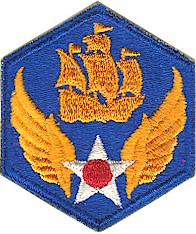 Shortly after the start of WWII, Civil Air Patrol in Michigan became attached to the Sixth Army Air Corps (and later Army Air Forces) based at Scott Field in Illinois. The three states in the 6th AAC's area were assigned assigned a numarical designation based on thier state's population: Illinois became 6-1, Wisconsin 6-2, and Michigan 6-3. All three of these states also placed their original designation on their wing shoulder patch.
Shortly after the start of WWII, Civil Air Patrol in Michigan became attached to the Sixth Army Air Corps (and later Army Air Forces) based at Scott Field in Illinois. The three states in the 6th AAC's area were assigned assigned a numarical designation based on thier state's population: Illinois became 6-1, Wisconsin 6-2, and Michigan 6-3. All three of these states also placed their original designation on their wing shoulder patch.
Other wings that have an AAC/AAF number on their patches are Rhode Island (1-6), New Jersey (2-2), Pennsylvania (3-1), Ohio (5-1), and Indiana (5-2). Alaska Wing's patch has "49" because it is the 49th state in the Union.
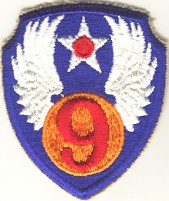
The Michigan Wing patch was authorized for wear December 5, 1949. This was of course after the Army Air Forces separated into its own branch in 1947. For some reason, Michigan Wing seems to have adopted the design of the 9th Air Force patch instead of the 6th AAF patch...Why?
Well, here are two plausable theories as good as any: Perhaps the Wing Commander at the time the patch was designed served in the 9th AAC/AAF, and wanted to honor that. Or, because 6 + 3 = 9! We may never know exactly what the reasons are, which is exactly why we need to document history as it happens - so it isn't forgotten!
Information provided by:
Major Andrew "Ace" Browning

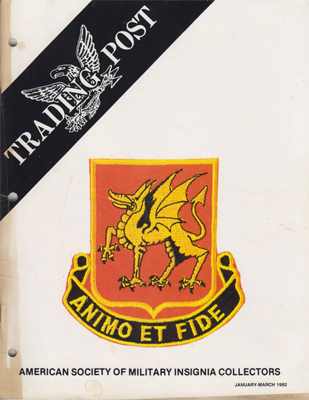

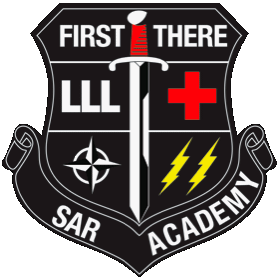 The Michigan Wing Search and Rescue Academy began in 1994 when a small group of members recognized the need for consistent, quality training in the field of Emergency Services and then designed a comprehensive school that could provide that training within the course of a week. Lead by the efforts of then Captain Sheila Cerny, they chose a location deep in the heart of the Huron National Forest that is unparalleled for teaching woodsmanship, navigation, and practical leadership. Long before task training was introduced by National Headquarters, the founders of SAR Academy created their own by deciding what knowledge was necessary for a Ground Team Member and then devising a method of testing that knowledge after it was taught.
The Michigan Wing Search and Rescue Academy began in 1994 when a small group of members recognized the need for consistent, quality training in the field of Emergency Services and then designed a comprehensive school that could provide that training within the course of a week. Lead by the efforts of then Captain Sheila Cerny, they chose a location deep in the heart of the Huron National Forest that is unparalleled for teaching woodsmanship, navigation, and practical leadership. Long before task training was introduced by National Headquarters, the founders of SAR Academy created their own by deciding what knowledge was necessary for a Ground Team Member and then devising a method of testing that knowledge after it was taught.
SAR Academy began with only one course, the Basic Course, which was designed to take members who had no previous ES training and provide them with all classroom and practical training necessary for them to become Ground Team Member Qualified. Over the next few years, SAR Academy continued to grow and expand to meet the increasing needs of its returning student population. By 1997, three new courses had been added: the Advanced Course, which provides more in-depth and thorough Ground Team Member training, the Medic Course, which provides students with all American Red Cross certifications below the level of Medical First Responder, and the Ground Team Leader Course, which is now named the Expert Course, and which provides members with all necessary training needed for Ground Team Leader qualification. In addition to Ground Team training, SAR Academy has provided its staff and students with Communication Unit Leader, Mission Radio Operator, Mission Observer, and Mission Scanner experience whenever the opportunity arises.
SAR Academy has had more than two hundred fifty graduates since its inception in 1994. Many of those graduates have gone on to successful careers in the military, in aviation, and in the business world. Still others remain within our program, diligently giving back to new students what knowledge they received themselves as students many years ago. As SAR Academy approaches its sixteenth year of operation, it has evolved into a school of utmost quality, having benefitted from the influence of the hundreds of staff members and students who have helped to make it what it is today. Even today you will see Major Cerny and other long standing attendees of the school roaming the woods of the Huron National Forrest playing major roles in the school. We thank her and others like her that have made SAR Academy successful and continue to set the standard for ground team members across the wing.
Information Provided by:
Michigan Wing
September 10, 2010

"At the time I [John DiGiantomasso] did the patch, 1977 or 1978, South Macomb was a powerhouse Cadet Squadron. We had just received our third straight Unit Citation award and had been named the National Squadron of Distinction, beating out two other squadrons in our same Group who came in 2nd and 3rd place nationally. At the time it was the first time that the top three squadrons nationally were in the same wing, let alone the same group."
"As such, we were somewhat considered rivals and were treated as outcasts (not too bad, more friendly than anything) but we didn't have a squadron patch. So I designed one with the front view of an F4U Corsair on it and the text "BLACK SHEEP" on the patch. I painted one and put it on the plexiglass of the squadron's vending machine. The TV Show "Black Sheep Squadron" was very popular at the time. Wing or Group Headquarters (I don't know which) said "We don't like the idea of a Squadron Patch with a Navy Plane on it. Why not make one with an Air Force plane?"
"About that time I was looking at a magazine and there was a McDonnell-Douglas advertisement with a picture of the brand-new F-15 Eagle in front of the jet more or less as you see it on the patch. I took that image, reversed it left to right, and added a CAP triangle and fit it to the patch shape and now I had an Air Force plane on our squadron patch. We had a contest of submissions and my design won in the balloting. That patch was approved by headquarters and somebody had them made up as the official Squadron 3-2 Patch."
Information provided by:
John DiGiantomasso and
2d Lt Mark L Curtis
June 2007

Colors Selection
 The Cessna airplane has changed its direction from the first version patch shown at left, and is now pointing to the Dexter side. This is because the symbol depicting the organizationís mission or history faces to the right side (dexter) and never to the left side (sinister) of the bearer. Also note that USAF emblems are required to incorporate two colors: Ultramarine blue representing "the sky" - the primary theater of Air Force operations; and yellow representing "the sun" and the excellence required of Air Force personnel.
The Cessna airplane has changed its direction from the first version patch shown at left, and is now pointing to the Dexter side. This is because the symbol depicting the organizationís mission or history faces to the right side (dexter) and never to the left side (sinister) of the bearer. Also note that USAF emblems are required to incorporate two colors: Ultramarine blue representing "the sky" - the primary theater of Air Force operations; and yellow representing "the sun" and the excellence required of Air Force personnel.Information provided by:
1st Lt Cindy E Lang, CAP
September 14, 2010

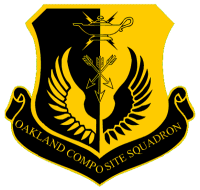 Blazon
Blazon
Field per pale Dexter Sable, Sinister Or.
Middle Chief Point, Lamp and four Lightning Bolts, Dexter Or, Sinister Sable.
Fess inverse arrows, Dexter Or, Sinister Sable.
Middle base Open Wings, Dexter Or, Sinister Sable.
Embroidered as Patch. Air Force Shield, Arms as listed above, Scroll Sable with Edged Or "Oakland Composite Squadron" Full Armorial.
Swiss Shield, Arms as listed above. Sable and Or Fleur, absent support, Argent Cadet Helm topped with Or and Sable Torse.
Crest is Sable Phoenix emerging from Fire in Or.
Herladry
This patch's elements signify our squadron's colors which represent Generosity and Elevation of the Mind (Or/Gold) and Clear Skies, Constancy, and the Grief that comes with the necessity of
our Search and Rescue Missions (Sable/Black).
The Lamp represents knowledge; its lack of flame represents the consistent need to seck new knowledge.
The Lightning Bolts represent our rapid development and deployment of our knowledge and skills. The Cluster of Arrows represents our military style training and using it for constant preparedness for its application in peace.
The wings represent our old Falcon and the Phoenix. The wings support us, represent our consistent rebirth, readiness for change and adaptability.
The design is what we wear to prove our ability and desire to constantly grow, adapt, and perfect our skills to be of service to our community, state, and nation.
History
This patch was designed in 2001 by SSgt Steve Saile to signify a major transition point in our squadron's history when it was apparent that the old ways the unit had conduclcd itself had died out. Many bad habits and practices were dropped, new commanders were stepping in, but we still wanted to maintain the old culture of pride, expertise, and fun. This patch includes many of the older elements of the previous patch which was a falcon on a blue field grasping a torch and lightning bolt.
Information provided by:
Captain Nick Ewing, Deputy Commander for Cadets, Oakland Comp Sq

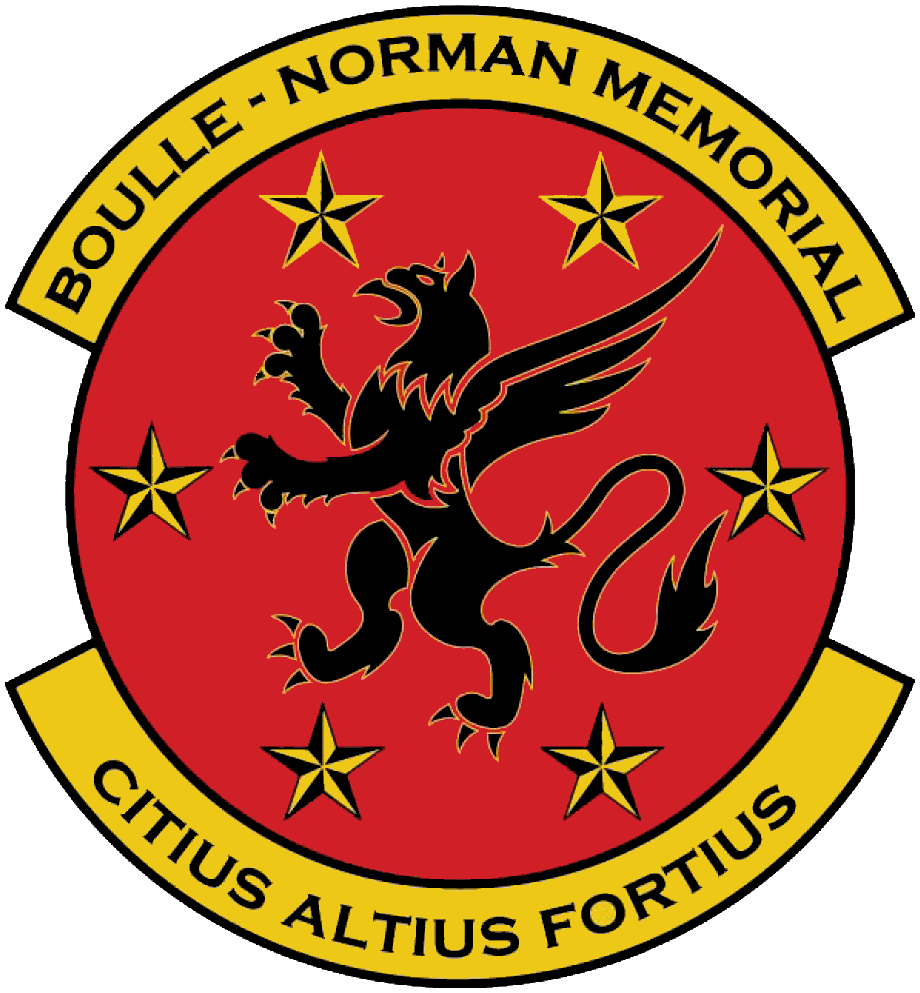
Unit Name:
Information provided by:
1st Lt Mark Curtis, CAP
Boulle-Norman Memorial Cadet Squadron
February 2010

Earned! Never Given!
The Maj Kevin A Adams Memorial Composite Squadron patch is one of many traditions held in the unit that pays homage to the unitís namesake. The patch is presented to all members who demonstrate their commitment and dedication to MI-655 and CAP by completing the first level of professional development (Maj Gen John F Curry Achievement for cadets and Level One for seniors). Any member wearing the patch is expected to be able to explain the history of the patch and describe what each element represents.
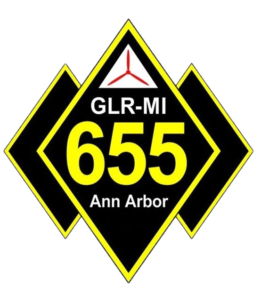
The Heraldry
The Maj Kevin A Adams Memorial Composite Squadron patch consists of a black diamond imposed over two smaller black diamonds so that their horizontal vertices are in line. The resulting shape is bordered in yellow. The primary diamond is charged with the Civil Air Patrol logo at middle chief and the numerals "655" in yellow at the fess point. Above the numerals is the squadron charter number and below the text "Ann Arbor" in silver.
The patch design is the graphical representation of the unit and represents the historical legacy of Maj Kevin A Adams.
The shape created by the three diamonds is symbolic of Maj Adamsí cadet grade insignia. It serves as a reminder of the goal each cadet of the unit should strive to achieve - the Gen Carl A Spaatz Award. The black of the diamondís field commemorates the mourning of his passing.
The CAP logo with the red tri-prop symbolizes the squadronís inclusion as part of CAP and the focus on the organizationís three primary missions: Cadet Programs, Aerospace Education, and Emergency Services.
The numerals "655" refer to our squadron identity. The numbers dually represent our squadron charter number and Maj Adamsí Spaatz award number. The yellow color of the numbers and the edge border represent "the sun" and the excellence required of all squadron personnel. Its inclusion indicates the status of the unitís affiliation to the U.S. Air Force as part of the civilian auxiliary.
The text "GLR-MI-655" is the unit Charter number and "Ann Arbor" is the community that the squadron serves.
Information provided by:
Maj Kevin A Adams Memorial Comp Sq